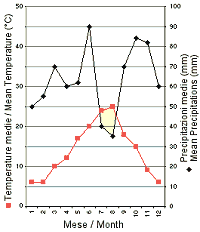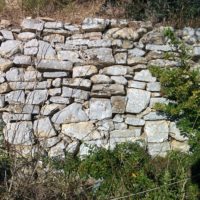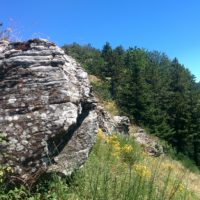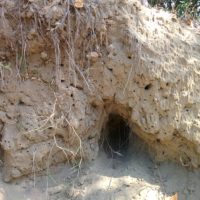Last updated on September 13th, 2020
Chrysidids are solitary wasps and in their life they are strictly linked to other solitary wasps (Sphecids, Apids, etc.), with whom they share the same environments. Generally chrysidids live in microhabitats characterized by environmental particularities which facilitate their recognition: flowers, arid and sandy solis, old woods exposed to the sun, pebbles, infested plants, etc.
 The most favorable environments are those characterized by xerothermic climatic periods, during which the curve of the summery medium temperatures exceeds the curve of the medium precipitations (Walter’s climograms). In a more generalized view, the chrysidids prefer subtropical-Mediterranean climates, with warm dried summery atmospheres tending to an arid climate with strong insolation and water deficit for the vegetation, which will be represented by thermophilous species.
The most favorable environments are those characterized by xerothermic climatic periods, during which the curve of the summery medium temperatures exceeds the curve of the medium precipitations (Walter’s climograms). In a more generalized view, the chrysidids prefer subtropical-Mediterranean climates, with warm dried summery atmospheres tending to an arid climate with strong insolation and water deficit for the vegetation, which will be represented by thermophilous species.
Some grassy cliffs and slopes, arid and insolated, oriented South-South East, and exposed to particularly dry climates are typical environments with a xerothermic regime. Usually, the climate is warm, semiarid to arid, mild during winter and with an average annual temperature of about 12°C (54°F). The pluviometric regime is characterized by a low annual precipitation (less than 1200mm, average about 700-800mm), with the maximum during spring and autumn and with the minimum in summer and winter. Winds blowing from south during summer, with consequent high temperatures and dehydration. The vegetation is characterized by a high variety and specialization of photophilous and thermophilous plants. In S Europe there are mediterranean species mixed with alpine species, of continental, balcanical and steppe-like origin (i.e. Eryngium campestre). Typical is the domominance of roverella and relicts of pine tree forests.

In detail, chrysidids are bound to extremely narrow microhabitats, comprising places of rest and of parasitic activity. It’s not difficult to see some specimens on uncovered soils already inhabited by other wasps, or near the worm-holes in wood searching for their nests. In the periods of flower blooming some species rest on inflorescences (Umbrelliferae, Compositae and Euphoribiae just to mention some) or are attracted by the sweet fluids on vegetables infested by Aphids. In other cases, some chrysidids can rest on rocks, leaves and lumber exposed to the sun, in correspondence of paths or along the banks of the rivers. Optimal observation places are the dried walls delimiting the agricultural fields and the walls exposed to the sun of the country houses.
Copyright, Authorship, and Ownership statements
All text and images of this page are copyright ©️ Chrysis.net unless otherwise stated - please see individual cases for authorship and copyright details. The specimens pictured are from the authors' or other collaborators' personal collections and from the collections of various museums. Unless otherwise specified, the whole content of this web site is for personal, non-commercial, scientific, and educational purposes given proper accreditation to the page from which they were derived are provided, and under Chrysis.net Terms and Conditions.
For citation purposes
Agnoli G.L. & Rosa P. (2025) Habitat of Chrysididae, in: Chrysis.net website. Interim version 31 March 2025, URL: https://www.chrysis.net/chrysididae/habitat-of-chrysididae/.












